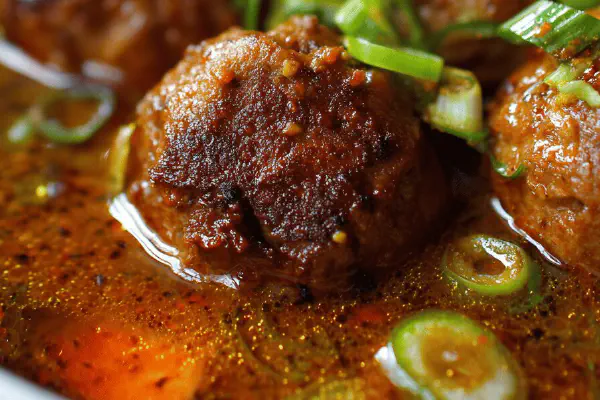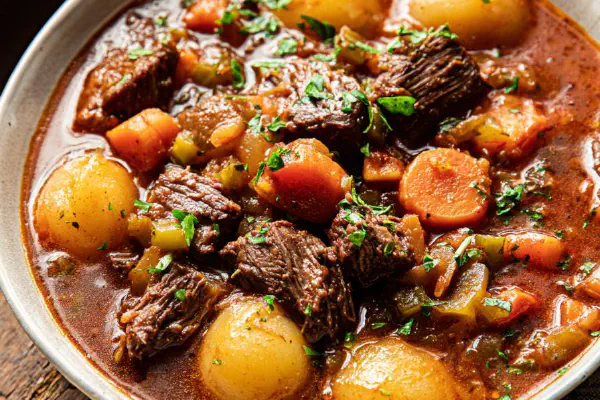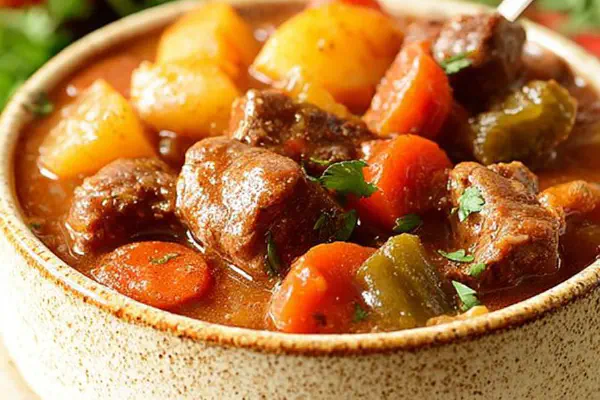Featured Recipe
Pork Stew with Yukon Gold

By Kate
"
Jarrets de porc slowly cooked with Yukon Gold potatoes in a mustard-scented broth. Uses chicken broth, bay leaf, onion, and garlic for depth. Meat braised until fork-tender, potatoes soft but intact. Oil used for searing to build fond. Adapted with parsnip for sweet earthiness, rosemary replacing bay leaf for fresh pine aroma. Simple, hearty, gluten and dairy free. Highlights layering flavors by browning meat, deglazing, then baking covered for even tenderizing. Flexible, forgiving technique. Can swap pork shoulder or beef shanks. Timing flexible; look for meat pull-apart texture and soft potato cubes.
"
Prep:
20 min
Cook:
Total:
Serves:
2 servings
stew
pork
comfort food
French cuisine
Introduction
Slow cooking pork shanks transforms tough connective tissues into silk. Not quick, but worth the wait. Yukon Gold potatoes chosen for their waxy texture — they hold despite the braise instead of turning to mush. Adding parsnip gives a subtle sweetness and breaks usual root-only routine. Rosemary swapped in for bay leaf cuts through fat with piney brightness. Key here: brown the meat well — don’t skip. Searing creates Maillard crust, building rich background flavors impossible to get otherwise. Cooking covered traps steam, making meat fall-off-the-bone tender. Patience, smell that garlicky onion softening, watch bubbling broth, poke potatoes to test doneness — kitchen alive. Practical—try shoulder if shanks unavailable; beef shanks work too but cook differently. Adjust broth if needed; want barely simmering finish, not boiling hard.
Ingredients
About the ingredients
Pork shanks offer perfect braise cut—plenty of collagen, some fat. Pat dry meat to brown well; wet meat steams instead. Dry mustard powder wakes citrus and heat notes; can swap Dijon mustard or ground horseradish as a twist. Chicken stock keeps flavor light; vegetable stock is fine for vegetarian variant though mind swaps flavor profile. Rosemary here replaces bay leaf to add needle-like aroma instead of subtle bitterness. Parsnip adds complexity and sweetness; you can sub carrots or celery root but parsnip most unique. Yukon Gold potatoes favored for texture resilience under long cook. Salt and pepper at stages crucial: first for searing, then final finish taste. Olive oil preferred neutral fruit flavor, but any vegetable oil works.
Method
Technique Tips
Start by preheating so oven ready when browning done. Brown pork well—don’t rush—color signals flavor. Sear on medium-high; too hot scorches without cooking inside. Reduce heat before onion/garlic to avoid burning. Stir mustard powder just enough to bloom aromas; too long and it dries out. Scraping fond during broth addition is non-negotiable — deepens broth complexity. Braising uncovered dries meat; cover tightly to trap moisture. Flip shanks halfway to even cooking and color, avoids one flat side dull looking. Test potatoes with fork — soft but not mush for best contrast. Remove rosemary stalk; chew on leaves bitter. Final rest lets juices redistribute, stopping meat from drying out on plate. Serve hot with a crunchy green veg cuts richness.
Chef's Notes
- 💡 Pat pork dry. Brown well; color means flavor. Let the fat cook off. Use medium-high heat for deep crust. If browning takes long, you are too cautious. Shallow or burnt sides harm depth.
- 💡 Searing builds flavor. Transfer pork, don’t crowd the pot. More water means more steam. Keep it tight while cooking. Flipping halfway gives even coloring; juicy, shreddy, excellent flavor.
- 💡 Stir veggies cautiously. Avoid burning garlic. Garlic browns fast; reduce heat right after adding. Mustard powder is quick; sprinkle and stir to wake up. Keep onion and garlic fragrant without molding.
- 💡 Braised meat texture means pull-apart. Watch for fork readiness; take it out slow. Cook long enough for flavors to marry. Don’t rush braising time. Let ingredients meld into one.
- 💡 Reverse substitutions: If pork is too fatty, replace with beef shanks. Try shoulder cuts if shanks aren't available. Roots can swap; carrots for sweetness. Parsnips bring unique notes.
- 💡 Oven proof dish needed? Cover tightly with foil if pot isn't safe. Good heat retention key for braising. Check that top lid seals; need moisture in pot. If broth too thick, adjust.
- 💡 Final seasoning check is essential. Rest meat means juicy bites. Don’t serve immediately; let juices settle into meat. Serve alongside greens for balance, needed crunch, freshness.
Kitchen Wisdom
What if meat tough?
Check oven temp. Low and slow wins here. Too hot cooks meat outside fast; inside stays tough. Adjust heat carefully—tenderness means a lot.
Broth flavor too weak?
Don't add too much. Liquid should be just covering base. Fond brings depth, don't drown flavors. Use low sodium options.
Potatoes mushy?
Stick with waxy potatoes. Larger cubes hold their shape. Starchy potatoes break apart quickly. Yukon Gold shines through braise, never mushy.
Storage advice?
Cool down fully before refrigerating. Store in airtight containers, freeze for longer life. Reheat on low; don't scold potatoes or they’ll collapse.



